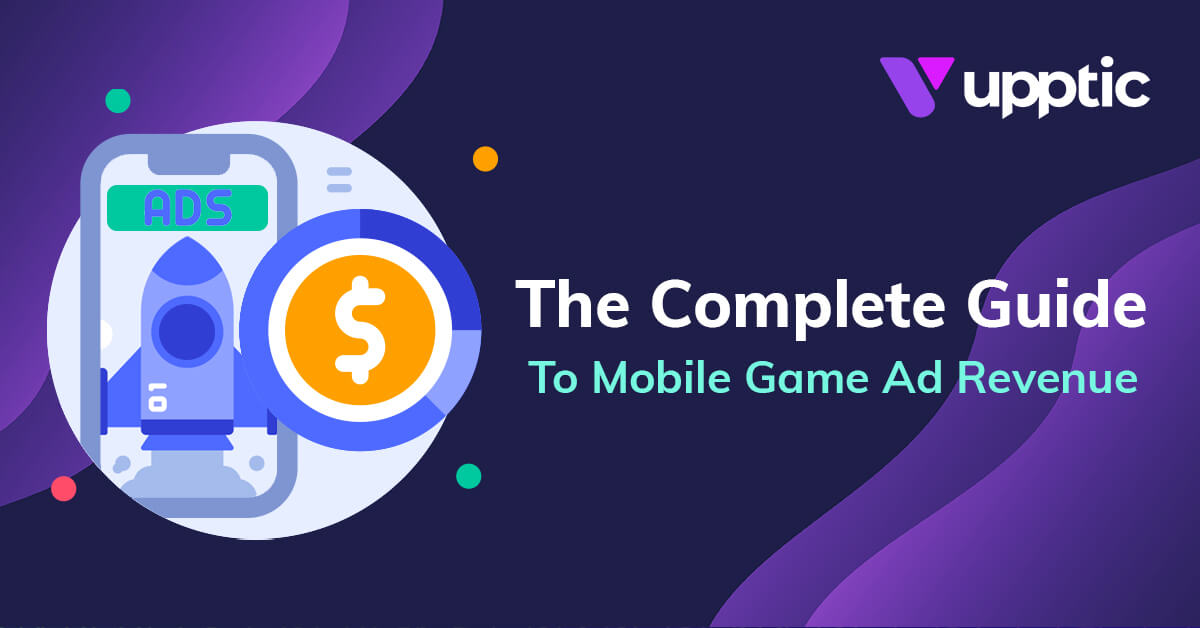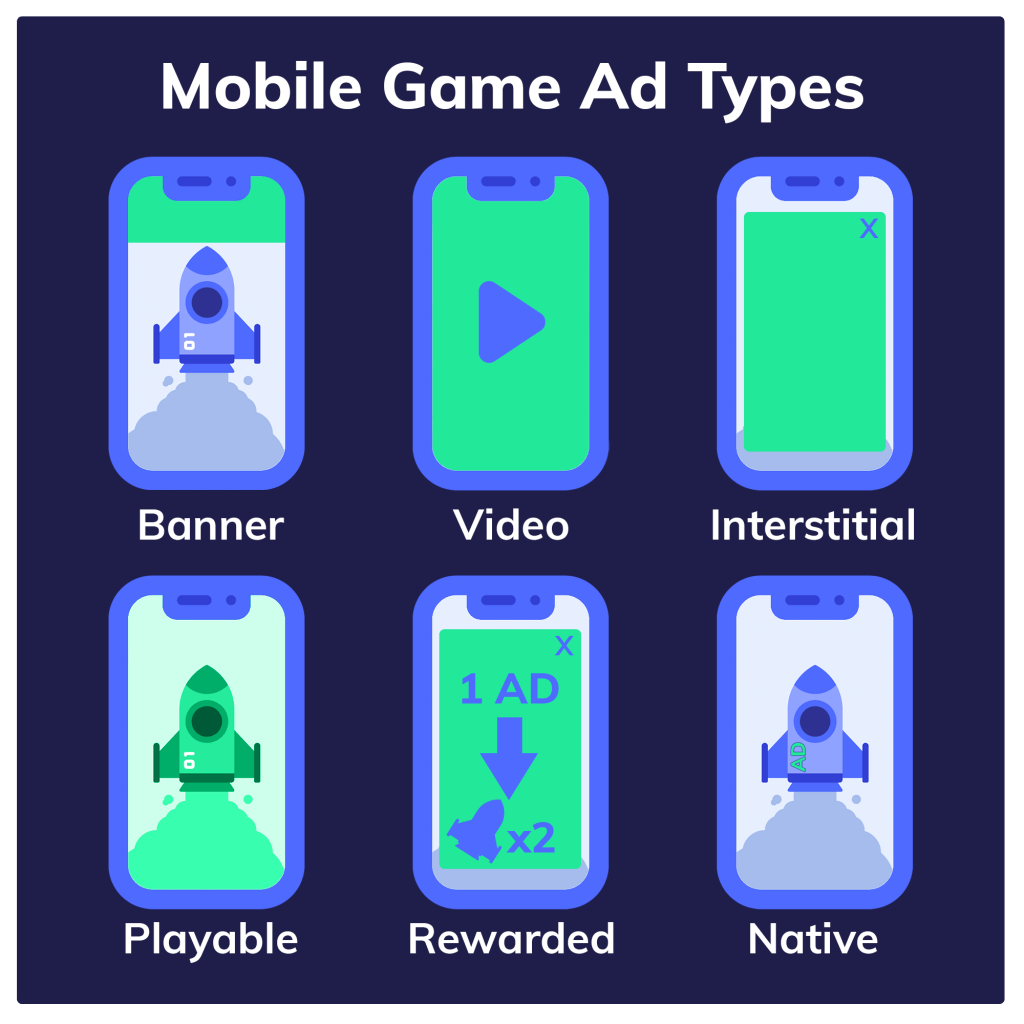Use this chapter selector for quick access to specific parts of this guide:
- The state of mobile gaming
- Revenue models in mobile games
- The mobile game advertising landscape
- Types of mobile game advertising
- Ad networks, platforms, and agencies
- From the advertiser’s point of view
- Best practices for generating ad revenue
- Maximizing placement value
- Understanding mobile in-game advertising
The industry has come a long way since its inception in the late 1990s. In those early days, games were little more than crude puzzle games and simple arcade titles. However, has exploded in recent years, thanks to the advent of powerful devices and ever-improving operating systems.
Today, games are big business, with some titles generating hundreds of millions of dollars in each year. And as the industry has grown, so too has the market.
In this guide, we will explore the state of , different models for publishers, different types of , and how each works. Further, we will share some best practices for publishers looking to use in- as a model.
The state of
In 2021, games accounted for an astounding 93 billion dollars in . For context, that means that games outpaced the combined of PC and console games. For comparison, global movie box office receipts for 2021 were 21.3 billion dollars. Now consider that the market is expected to grow by 66 billion dollars in the next five years and the rocket ship that represents is hard to deny.
Factors driving this growth go far beyond the global mass adoption of smartphones. Even twenty years ago, games like “Snake,” “Brickbreaker,” and even “Pong” could be found on candy-bar phones and early not-quite-smart devices. Point of fact, the growth in the sector is the result of improved connectivity to deliver a superior and new models. These models give publishers the ability to generate significant sums of without distracting or interrupting gameplay. These streams then fund more – and better – games, creating a virtuous cycle that benefits everyone with an interest in .
One of the most important things to understand about is that it is still a relatively young and evolving industry. The landscape is constantly changing and new ad formats, delivery methods, and measurement tools are being developed all the time. This can make it difficult to keep up with the latest trends and best practices.
models in games
Most every and publisher is interested in profiting from their creations. In addition to invested time and energy, some of them also have significant development and marketing expenditures. As a result, it is important for publishers to understand what options are available for generation and, hopefully, actual profits. Regardless of the you use – like or the – there are a few different models that a can choose from when it comes to games.
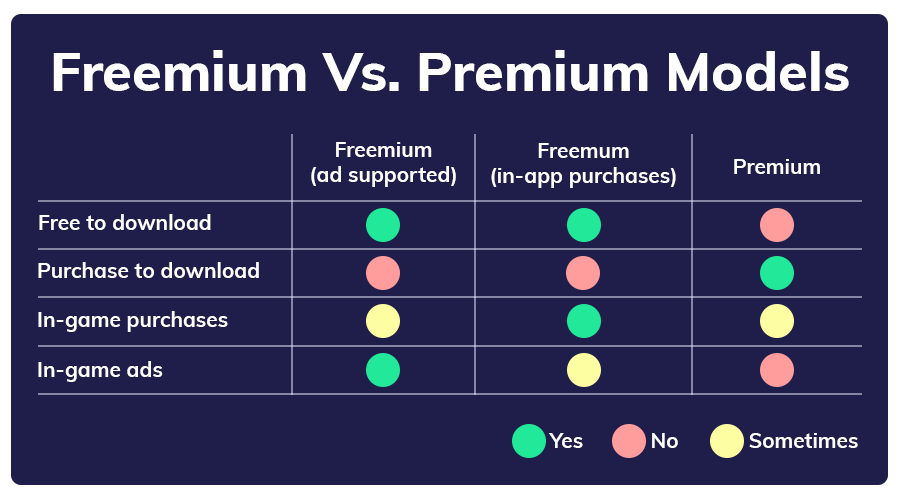
Freemium
The most popular model for games is the freemium model. Under this model, instead of , the is offered for free to . However, can also choose to pay for in- items or features that improve their experience. Its popularity is due, in part, to the fact that it allows publishers to monetize a larger number of while still providing a quality experience.
Often, the freemium model utilizes a combination of in- purchases and games supported by .
Premium
In contrast to the “freemium” model of generating through is the premium model. This is the simplest model for games. In this model, pay a set price to download the and can then play it without any further interruptions. The may have microtransactions, but these transactions are generally used to enhance the gameplay experience and are not required in order to progress. This was the original model for games, and still exists, but it has largely been supplanted in favor of the freemium model.
In-
In- (IAP) are a way for developers to monetize their after they have been downloaded. In this model, can purchase in- items, power-ups, and other enhancements that improve their gameplay experience. IAP can be a great way to generate , but it is important to strike the right balance. If IAP is used in a way that feels too “pay to win”, it can quickly turn off the average and damage your ’s reputation.
In-
In- (IGA) is a model that has been gaining popularity in recent years. In IGA, advertisers pay to have their ads displayed within the . These ads can take many different forms, but the most common are banner ads, video ads, and . In- can be a great way to generate without asking your to pay. IGA as part of a mix is critical for generating value from under-monetizing player cohorts.
The landscape
is a rapidly growing industry. In 2020, ad spending was expected to reach $7.4 billion dollars and it is projected to grow to $17.5 billion by 2024. This growth is being driven by the continued growth of the industry as well as the increasing sophistication of platforms.
In- allows developers to place ads within their games, and earn money each time a player views or clicks on an ad.
If you’re new to the space, here are some terms you’ll want to know:
CPM
“Cost per mille” or “cost per thousand” – CPM is the effective cost an advertiser pays for every thousand impressions (an is essentially an ad view) within a publisher’s .
CPC
“Cost per click” – CPC is how much an advertiser pays for each user who clicks on their ad within a ’s .
CPI
“Cost per install” – CPI is how much an advertiser pays an install that comes via an ad they placed within a publisher’s .
CPA
“Cost per action” – CPA is what an advertiser pays a for a user who performs a specific action (sometimes called a conversion) through an ad placed in their .
ROAS
“Return on ad spend” – ROAS based buying is where an advertiser is willing to bid more for buying from apps and placements that bring them more generating . This can be done either algorithmically or through manual bid adjustments
While there are different ways an advertiser can purchase inventory – most notably CPM, CPC, and CPI – on the publisher’s side, almost all inventory is actually sold on CPM. Algorithms can use CPC, CPI, and CPA to help inform the final CPM.
This is because most monetization platforms default to a CPM model for their payouts – developers actually have very little say in how ads are served. Advertisers will often try multiple bidding techniques including CPI, CPA and ROAS based bidding to see what will most effectively achieve their goals.
Types of
works by connecting advertisers with publishers. Advertisers pay to have their ads displayed in games and publishers receive a portion of the .
There are a few different types of that publishers can choose from. The most common kind of ads are banner ads, video ads, , and playable ads.
Banner ads
A is the simplest form of . They are typically small rectangular ads that are displayed at the top or bottom of the screen. Banner ads can be static or animated and are usually less than 30 seconds in length.
Video ads
A is a more engaging form of . A more , they are typically 15-30 seconds in length and can be either skippable or non-skippable. Skippable video ads give the option to skip the ad after a few seconds, while non-skippable video ads must be watched to completion. Often a can also be combined with mechanics to act as a .
An is a full-screen ad that is displayed between levels or at other natural breaks in gameplay. They are typically 15-30 seconds in length and can be either skippable or non-skippable.
Playable ads
Playable ads allow users to play a sample of the before downloading it. These ads are very effective because they make the experience more dynamic than ever before. Instead of a video or static advertisement that can be buried, ignored, or overlooked, playable ads allow users to try before they buy. This is more effective for advertisers, as more downloads come from that have already tried the before.
are, quite simply, ads that users are rewarded for viewing. Most commonly these come in the form of ads that can watch in exchange for in- currency or useful in- items.
Incentivized ads
Incentivized ads are ads that reward in one for completing objectives in another . For instance, an ad in 1 might tell a user to finish Quest X in 2 in order to receive 200 gold coins in 1.As you can see, while reward simply viewing the ad, Incentivized ads actually move the player into the other to complete an action and receive their incentive.
A , ideally, doesn’t really look like an ad at all. It’s embedded so cohesively with the surrounding environment that it just seems like part of the . An example could be a billboard for an actual product in the downtown area of a or a radio spot that comes on while driving in a car simulator .
Ad networks, platforms, and agencies
Most publishers work with ad networks, which are intermediary companies that help connect advertisers with publishers. An is a third-party company that connects advertisers with publishers. is one such example. They typically have a large inventory of ad space from many different games and apps, and they use algorithms to match advertisers with the right publishers.
Ad mediation platforms are a critical piece of technology developed by the most sophisticated ad networks. These platforms offer tools to help publishers manage ad inventory and optimize their . Some advanced ad mediation platforms use a process called real-time bidding (RTB) to deliver ads to games. In RTB, advertisers compete to have their ad displayed in a particular ad placement within a . The winning bidder is then charged the amount that they bid and their ad is displayed in the .
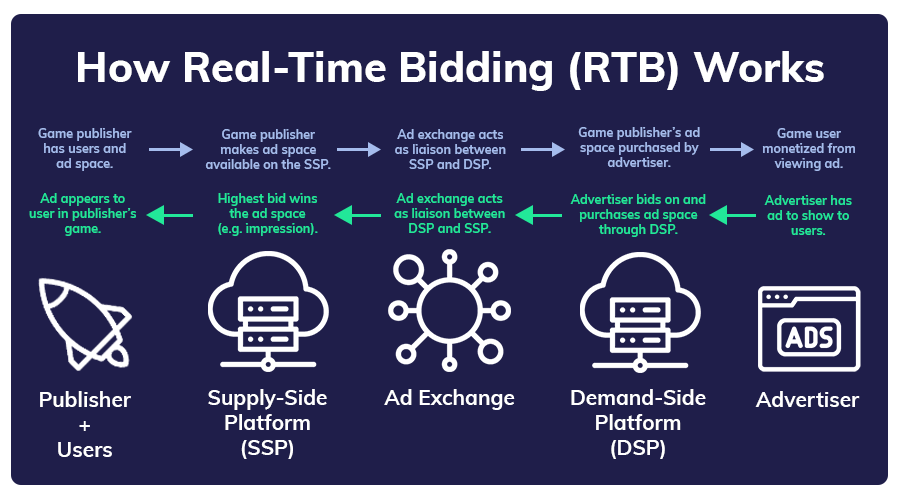
There are a number of ad mediation platforms that publishers can choose from. The most popular of these platforms are , AppLovin, and IronSource. AdMob is a platform that is owned by Google. AppLovin and Ironsource are platforms focused on user acquisition through ads.
Additionally, there are marketing agencies which specialize in different types of ads or marketing strategies. Agencies aren’t plugged into ad networks, but they can be a great source for creatives and strategy. Chartboost specializes in , for instance, while Upptic specializes in videos and trailers.
From the advertiser’s point of view
To best understand how to optimize the ad experience in your games, it is important to understand the point of view that advertisers are likely to have.
When in a , advertisers are looking for an immersive and engaging experience for their users. They want their ads to blend in with the content and not disrupt the player’s experience. Advertisers also want their ads to be as effective as possible, driving users to take a direct response or action that moves their business forward. As a result, they will likely test different ad formats and targeting strategies to see what works best.
Advertisers run the gamut from Fortune 100 companies like Coca-Cola to small and regional companies looking to build brand awareness. In fact, one of the largest segments of in- advertisers is other software publishers trying to generate interest in new titles and games. The variety of organizations that may take an interest in in your is nearly endless.
As a result, your decisions about availability, placements, and rates should not be determined or decided based on desperation but rather with an understanding that there are plenty of options so long as in your provides value to their brand.
Best practices for generating a
When developing an strategy, it’s important to keep in mind the needs of both the developers and the advertisers. Here are some best practices for developers to follow when considering .
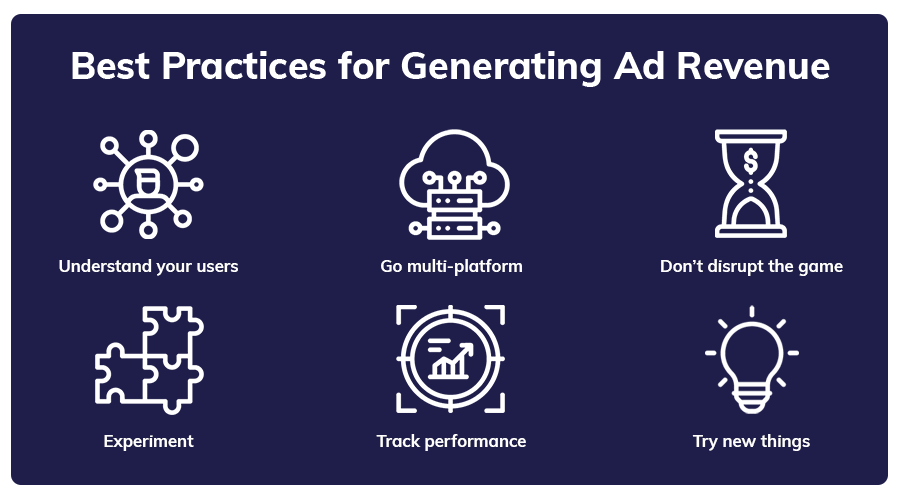
Understand your user base
It’s important to understand who your are and what they’re likely to be interested in. This will help you choose the right and the right placement for your ads.
Go multi-platform with your game
The more devices your can be played on, the more potential you can generate from .
Do not disrupt the experience
Ads should never interfere with the gameplay or the . If done correctly, ads can enhance the experience by providing additional content or rewards for .
Experiment with different ad formats
There are many different types of ads, including banner ads, , video ads, and . Try out different ad formats to see which ones work best for your and your .
Track performance
Use analytics to track the performance of your ads and optimize your . The beauty of most platforms and ad creatives is that they can be changed quickly to maximize results. Use data to inform decisions about optimizing placements, rotations, and messaging.
Don’t be afraid to try new things
One of the best ways to maximize your is to be original with your ads. If you can come up with new and innovative ad formats that are interesting and engaging for , you’ll be more successful in attracting advertisers. Don’t be afraid to experiment with different types of ads, and track the performance of each one to see what works best for your .
Maximizing placement value
Maximizing placement value is about more than money. Each placement has additional, intrinsic value. It is crucial for both publishers and advertisers alike to capitalize on this additional value.
The most obvious value in an advertisement for the publisher is . Different placements at different points of gameplay will carry different prices for advertisers. Advertisers will be wanting the greatest possible value for their investment just as publishers will want to maximize their remuneration.
Brand lift and association
In addition to , in- advertisements can drive brand lift for publishers and advertisers alike. Advertisers want to be associated with successful and innovative products. For publishers, having big-budget advertisers associated with their games can help to legitimize them in the eyes of and other potential partners.
Data
Another value that placements hold is data. Advertisers are always looking for ways to collect more data about their target audiences. In- provides a unique opportunity for advertisers to collect data about player behavior. This data can be used to inform future ad campaigns and to improve the targeting of ads.
User Acquisition
In- provides an opportunity for advertisers to reach new audiences that they may not have been able to reach through other channels. Advertisers can use in- to reach who are not actively seeking out their products or services.
User Retention
In- can also be used by publishers to increase their own user retention for games. Publishers can use to keep engaged and inside their own games longer. Additionally, they can cross-promote their other titles within their games – which can lead to further engagement and retention.
Understanding m in-g a
In- is a great way for publishers to make money. It can also help to increase user acquisition and retention, and it provides an opportunity for advertisers to reach new audiences. Understanding in- is crucial for success in this area. By understanding the different models, ad formats, and best practices, you can maximize your .
Upptic helps games and apps scale profitably by leveraging user acquisition, creative, data science and ASO.
If you’re interested in learning more, let’s talk.
SOURCES
The mobile games market is making more money than PCs and consoles combined
Mobile Gaming Market by Platform and Geography – Forecast and Analysis 2022-2026

